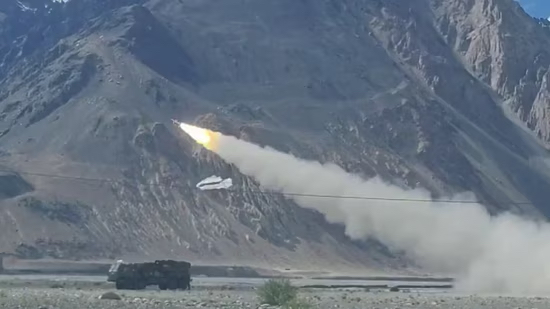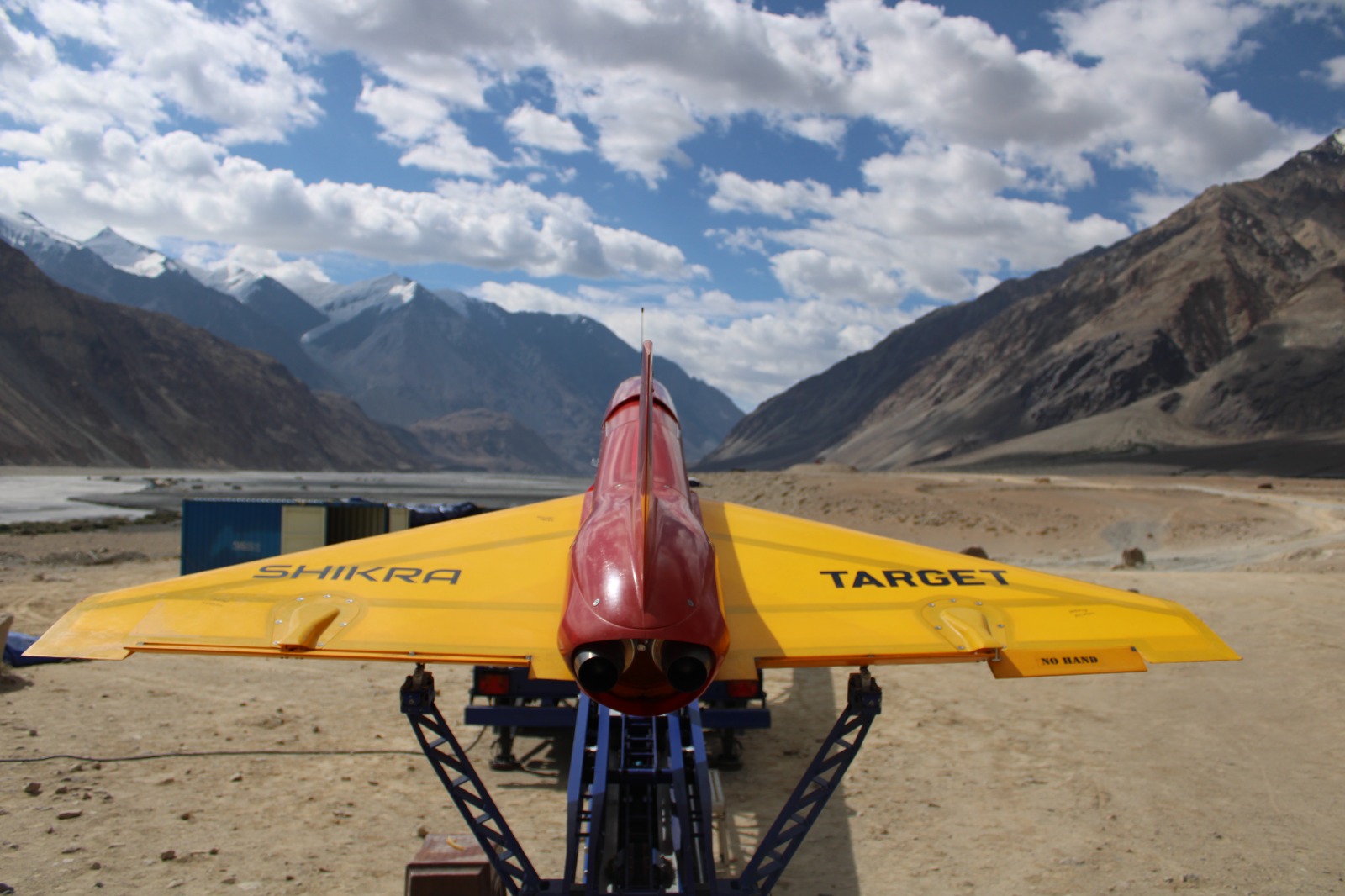 Akash Prime during its validation test in Ladakh.
Akash Prime during its validation test in Ladakh.
New Delhi: India has successfully validated its upgraded Akash Prime surface-to-air missile system in challenging high-altitude conditions in Ladakh, destroying two high-speed unmanned targets at 15,000 feet above sea level on Wednesday, the Ministry of Defence said on Thursday. The milestone test clears the way for deploying two new Indian Army regiments along the India-China frontier as part of the country’s layered air defence strategy.
The missiles successfully intercepted and neutralized HSHA (high-speed, high-altitude) aerial targets, flown with precision under extreme weather and atmospheric pressures. The Shikra target systems were developed and operated by Anadrone Systems Pvt Ltd (ASPL), one of India’s top manufacturers of aerial target systems under various categories.
The trials, conducted on the eastern Ladakh plateau at approximately 4,600 metres above sea level, saw the missile system demonstrate remarkable precision in the rarefied Himalayan air. Participants included the Army Air Defence Corps, Defence Research and Development Organization (DRDO), Bharat Dynamics Limited (BDL), and Bharat Electronics Limited (BEL).
The test involved engaging two fast-moving and manoeuvring Shikra drones, simulating cruise missile and drone threats. Both targets were destroyed with direct hits using first production-model missiles, with no telemetry anomalies reported – a significant achievement given the extreme operating conditions.
 The ASPL Shikra target drone. (India Sentinels photo)
The ASPL Shikra target drone. (India Sentinels photo)
Technical breakthrough
High-altitude firings present unique challenges for missile systems, testing propulsion, seeker lock capabilities, datalink strength, and fuze logic in cold, low-density air. The Akash Prime’s ramjet engine maintained thrust effectiveness despite the thin atmosphere, while its indigenous active radio-frequency seeker—a key upgrade from earlier variants – sustained target lock beyond 25 kilometres.
The system’s modified radars and power plants successfully operated in temperatures of minus 15-degrees celsius, demonstrating the ruggedization efforts undertaken following lessons from Operation Sindoor, Pakistan’s drone and missile campaign in May 2025. During that operation, earlier Akash batteries achieved multiple kills, providing valuable feedback that prompted seeker upgrades and enhanced durability features now proven at altitude.
DRDO classified the firing as the First of Production Model trial, the final step before bulk delivery. Serial production lines at BDL Hyderabad have already achieved 82% indigenous content, projected to reach 93% by the third production lot, significantly reducing import dependence.
Strategic implications
The successful validation carries immediate strategic significance for India’s northern frontier. The army will raise its third and fourth Akash Prime regiments under an ₹8,160 crore contract signed in 2023, providing 360-degree air defence cover to the northern theatre. Each regiment fields two firing groups, eight launchers, and 96 ready-to-fire missiles, creating an inner defensive shield within the S-400 and medium-range surface-to-air missile envelope.
The timing is particularly relevant given increased Chinese drone reconnaissance activities along the line of actual control (LAC). The People’s Liberation Army Air Force frequently operates reconnaissance drones over ridge lines, and the Prime’s validation demonstrates India’s capability to engage such targets even from forward posts in challenging terrain.
The system’s enhanced capabilities also signal India’s growing confidence in indigenous defence technology. Nations that previously showed reluctance toward older Akash variants, including Brazil, are reportedly reconsidering their positions following the seeker-equipped missile’s production certification.
Advanced capabilities set Prime apart
The Akash Prime represents a significant evolution from its predecessor, the Akash Mk-1. While maintaining the same 18-kilometre flight ceiling, the Prime extends intercept range to 30 kilometres – a 20% improvement over the original 25-kilometre capability. The addition of an indigenous active RF seeker for terminal guidance transforms the weapon from a purely command-guided system to a hybrid fire-and-forget platform.

This technological advancement dramatically improves single-shot kill probability to over 90% while enhancing resilience to electronic jamming. The seeker’s Ku-band active capability, co-developed by DRDO and BEL, includes coded pulse emission and home-on-jam functionality, where jamming attempts actually boost track certainty.
The missile’s integrated ramjet-rocket sustainer maintains supersonic speeds of Mach 2.5 to 3 throughout terminal manoeuvres, powered by a new cermet nozzle throat liner designed to withstand –40-degrees celsius start-up shocks. A 60-kilogram pre-fragmented warhead uses a smart proximity fuze with selectable burst patterns – cubic for drones, spherical for aircraft – to minimize wastage and collateral damage.
Ground systems have been similarly enhanced. The Rajendra-III phased-array radar can now cue targets at 60 kilometres while simultaneously guiding eight missiles in salvos. A distributed Akashteer command-and-control node fuses feeds from central acquisition radar and low-level gap-filler radars, with software incorporating drone-swarm discrimination algorithms refined during recent operations.
Production and industrial impact
The validation opens the door for accelerated production and deployment. BDL will deliver 48 missiles in the first lot by December 2025, expanding to 96 per year from 2026. The program supports over 200 micro, small, and medium enterprises (MSMEs) supplying avionics harnesses, composite fins, and RF attenuators, aligning with the government’s Atmanirbhar Bharat (self-reliant India) initiative.
The missile’s open-architecture software design allows seamless integration with India’s Integrated Air Command and Control System, enabling shoot-on-remote engagements and sensor-shooter decoupling. This networking capability significantly extends the system’s operational flexibility and effectiveness.
Future upgrades include a software-defined seeker permitting mid-life waveform refresh, crucial for maintaining technological superiority through 2040. The system’s reduced ground-system footprint – achieved through compact power packs – enhances deployment speed and reduces signature visibility.
Export potential and future
The Akash Prime’s terminal seeker capability reduces reliance on ground illumination systems, making it attractive to nations lacking comprehensive long-range radar networks. This feature has been highlighted in discussions with potential customers including Armenia and Vietnam, who find the reduced integration costs appealing.
The success also accelerates development of the next-generation Akash-NG system, featuring dual-pulse rocket propulsion and 70- to 80-kilometre range with an active electronically scanned array multi-function radar. Flight-tested four times, the Akash-NG is scheduled for user trials in 2026.
The Ladakh validation represents more than a technical achievement – it demonstrates India’s capacity to defend its highest frontiers with fully indigenous technology. By proving seeker accuracy, ramjet reliability, and system ruggedness in extreme conditions, the Akash Prime positions itself as the army’s primary air defence workhorse for the northern theatre and a competitive export product.
The milestone underscores DRDO’s iterative development approach, incorporating combat feedback into rapid upgrades and achieving user-verified certification within four years of maiden flight. As India strengthens its layered air defence architecture, the Akash Prime system provides a crucial middle-tier capability bridging point defence and long-range interception systems.
With production certification complete and deployment imminent, the Akash Prime represents a significant step forward in India’s defence modernization efforts, particularly relevant as the country faces evolving aerial threats along its contested borders. The system’s proven performance in Ladakh’s challenging environment provides confidence in its operational effectiveness across India’s diverse geographical and climatic conditions.
